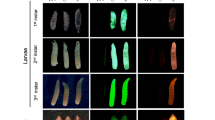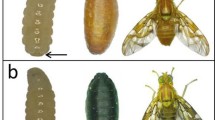Abstract
The wild-type allele of a “dark pupae” mutant of the Mediterranean fruitfly,Ceratitis capitata Wied. was translocated to the male's Y-chromosome. Through a series of crosses and backcrosses, 2 lines of the Mediterranean fruitfly with the male linked translocation were produced. These lines produced continuously wild-type (brown pupae) males and mutant “dark pupae” females. The lines are true-breeding. Automated sex-sorting of such lines may be feasible using the pupal color dimorphism.
Résumé
L'allèle du type sauvage d'un mutant «pupe noire» de la mouche méditerranéenne des fruits,Ceratitis capitata Wied. a été transféré sur le chromosome X du mâle. Par toute une série de croisements et de croisements réverses, 2 lignées de mouches ayant cette translocation liée au mâle ont été obtenues. Ces lignées produisent de façon continue des mâles du type sauvage (pupes brunes) et des femelles mutantes aux pupes noires. Ces lignées faciles à élever permettent la séparation des sexes d'après le dimorphisme dans la couleur des pupes.
Similar content being viewed by others
References
Bushland, R. C.—1971. Sterility Principle for Insect Control or Eradication: Historical development and recent innovations.—I.A.E.A. STI Pub. 265 Vienna, 542 pp.
Davidson, G.—1974. Genetic Control of Insect Pests.—Acad. Press. Lond. New-York, 158 pp.
de Murtas, I. D., Cirio, U., Guerrieri, G. & Enkerlin, S., D—1970. An experiment to control the Mediterranean fruitfly on the island of Procida by the Sterile-Insect-Technique.—I.A.E.A. STI. PUB/276, Vienna, 175 pp.
Fay, R. W. &Morlan, H. B.—1959. A mechanical device for separating the developmental stages, sexes and species of mosquitoes.—Mosquito News. 19, 144–147.
Proverb, M. D.—1974. Codling moth control by the sterility principle in British Columbia: Estimate cost and some biological observations related to cost.—I.A.E.A STI. Pub/364, Vienna, 137 pp.
Robinson, A. S.—1976. Progress in the use of chromosomal translocations for the control of insect pests.—Biol. Rev., 51, 1–24.
Rössler, Y. &Koltin, Y.—1976. The genetics of the Mediterranean fruitflyCeratitis capitata: Three morphological mutations.—Ann. Entomol. Soc. Am., 69, 604–608.
Whitten, M. J.—1969. Automated sexing of pupae and its usefullness in control by sterile insects.—J. Econ. Entomol., 62, 272–273.
Whitten, M. J. &Foster, G. G.—1975. Genetical methods of pest control.—Annu. Rev. Entomol., 20, 461–476.
Whitten, M. J. &Taylor, W. C.—1970. A role for the sterile female in insect control.—J. Econ. Entomol., 63, 269–272.
Author information
Authors and Affiliations
Additional information
The investigation was partially supported by I.A.E.A. Grant No. 1902/RB.
Rights and permissions
About this article
Cite this article
Rössler, Y. Automated sexing ofCeratitis capitata [Dip.: Tephritidae]: The development of strains with inherited, sex-limited pupal color dimorphism. Entomophaga 24, 411–416 (1979). https://doi.org/10.1007/BF02374180
Issue Date:
DOI: https://doi.org/10.1007/BF02374180




